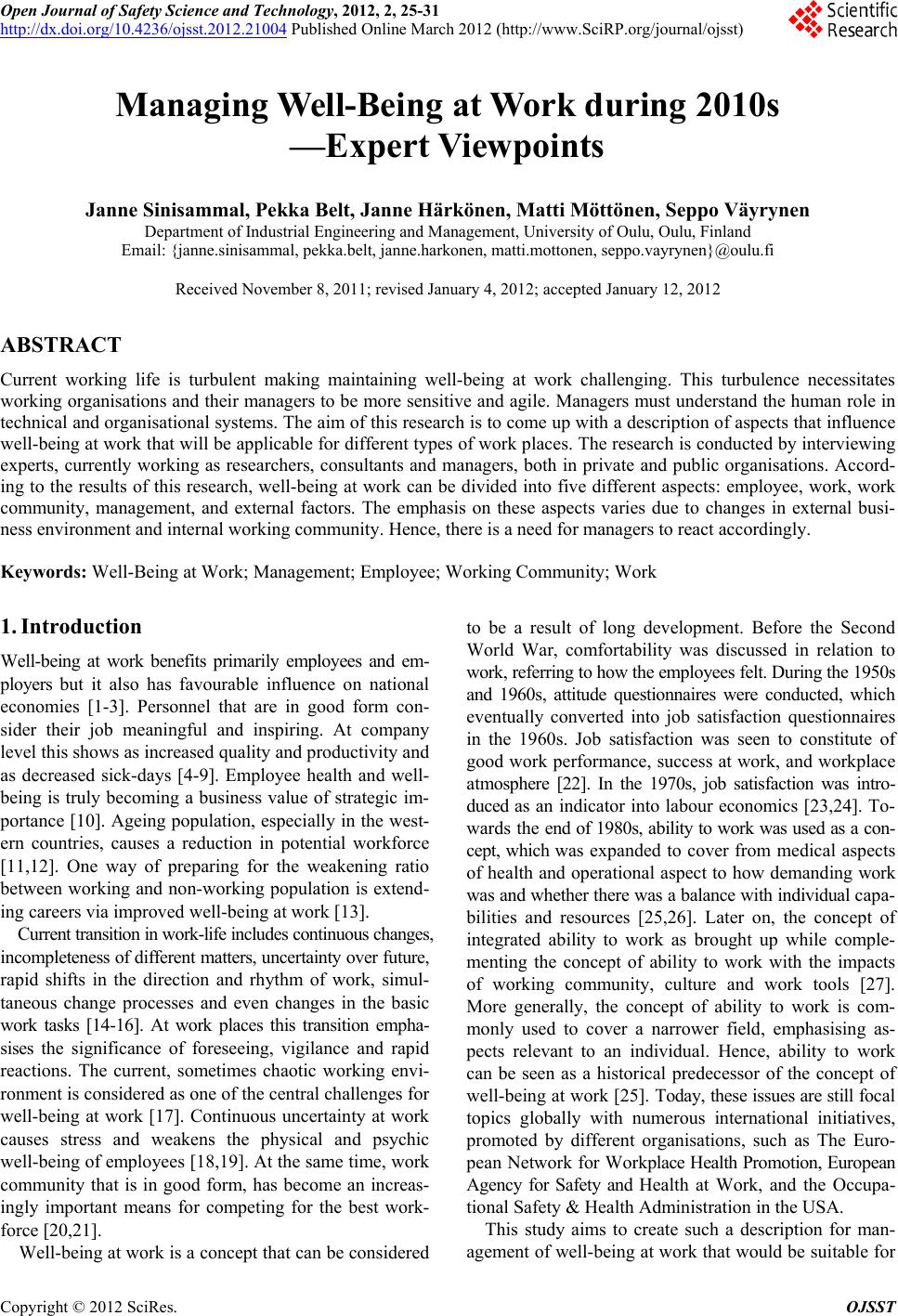 Open Journal of Safety Science and Technology, 2012, 2, 25-31 http://dx.doi.org/10.4236/ojsst.2012.21004 Published Online March 2012 (http://www.SciRP.org/journal/ojsst) Managing Well-Being at Work during 2010s —Expert Viewpoints Janne Sinisammal, Pekka Belt, Janne Härkönen, Matti Möttönen, Seppo Väyrynen Department of Industrial Engineering and Management, University of Oulu, Oulu, Finland Email: {janne.sinisammal, pekka.belt, janne.harkonen, matti.mottonen, seppo.vayrynen}@oulu.fi Received November 8, 2011; revised January 4, 2012; accepted January 12, 2012 ABSTRACT Current working life is turbulent making maintaining well-being at work challenging. This turbulence necessitates working organisations and their managers to be more sensitive and agile. Managers must understand the human role in technical and organisational systems. The aim of this research is to come up with a description of aspects that influence well-being at work that will be applicable for different types of work places. The research is conducted by interviewing experts, currently working as researchers, consultants and managers, both in private and public organisations. Accord- ing to the results of this research, well-being at work can be divided into five different aspects: employee, work, work community, management, and external factors. The emphasis on these aspects varies due to changes in external busi- ness environment and internal working community. Hence, there is a need for managers to react accordingly. Keywords: Well-Being at Work; Management; Employee; Working Community; Work 1. Introduction Well-being at work benefits primarily employees and em- ployers but it also has favourable influence on national economies [1-3]. Personnel that are in good form con- sider their job meaningful and inspiring. At company level this shows as increased quality and productivity and as decreased sick-days [4-9]. Employee health and well- being is truly becoming a business value of strategic im- portance [10]. Ageing population, especially in the west- ern countries, causes a reduction in potential workforce [11,12]. One way of preparing for the weakening ratio between working and non-working population is extend- ing careers via improved well-being at work [13]. Current transition in work-life includes continuous changes, incompleteness of different matters, uncertainty over future, rapid shifts in the direction and rhythm of work, simul- taneous change processes and even changes in the basic work tasks [14-16]. At work places this transition empha- sises the significance of foreseeing, vigilance and rapid reactions. The current, sometimes chaotic working envi- ronment is considered as one of the central challenges for well-being at work [17]. Continuous uncertainty at work causes stress and weakens the physical and psychic well-being of employees [18,19]. At the same time, work community that is in good form, has become an increas- ingly important means for competing for the best work- force [20,21]. Well-being at work is a concept that can be considered to be a result of long development. Before the Second World War, comfortability was discussed in relation to work, referring to how the employees felt. During the 1950s and 1960s, attitude questionnaires were conducted, which eventually converted into job satisfaction questionnaires in the 1960s. Job satisfaction was seen to constitute of good work performance, success at work, and workplace atmosphere [22]. In the 1970s, job satisfaction was intro- duced as an indicator into labour economics [23,24]. To- wards the end of 1980s, ability to work was used as a con- cept, which was expanded to cover from medical aspects of health and operational aspect to how demanding work was and whether there was a balance with individual capa- bilities and resources [25,26]. Later on, the concept of integrated ability to work as brought up while comple- menting the concept of ability to work with the impacts of working community, culture and work tools [27]. More generally, the concept of ability to work is com- monly used to cover a narrower field, emphasising as- pects relevant to an individual. Hence, ability to work can be seen as a historical predecessor of the concept of well-being at work [25]. Today, these issues are still focal topics globally with numerous international initiatives, promoted by different organisations, such as The Euro- pean Network for Workplace Health Promotion, European Agency for Safety and Health at Work, and the Occupa- tional Safety & Health Administration in the USA. This study aims to create such a description for man- agement of well-being at work that would be suitable for C opyright © 2012 SciRes. OJSST 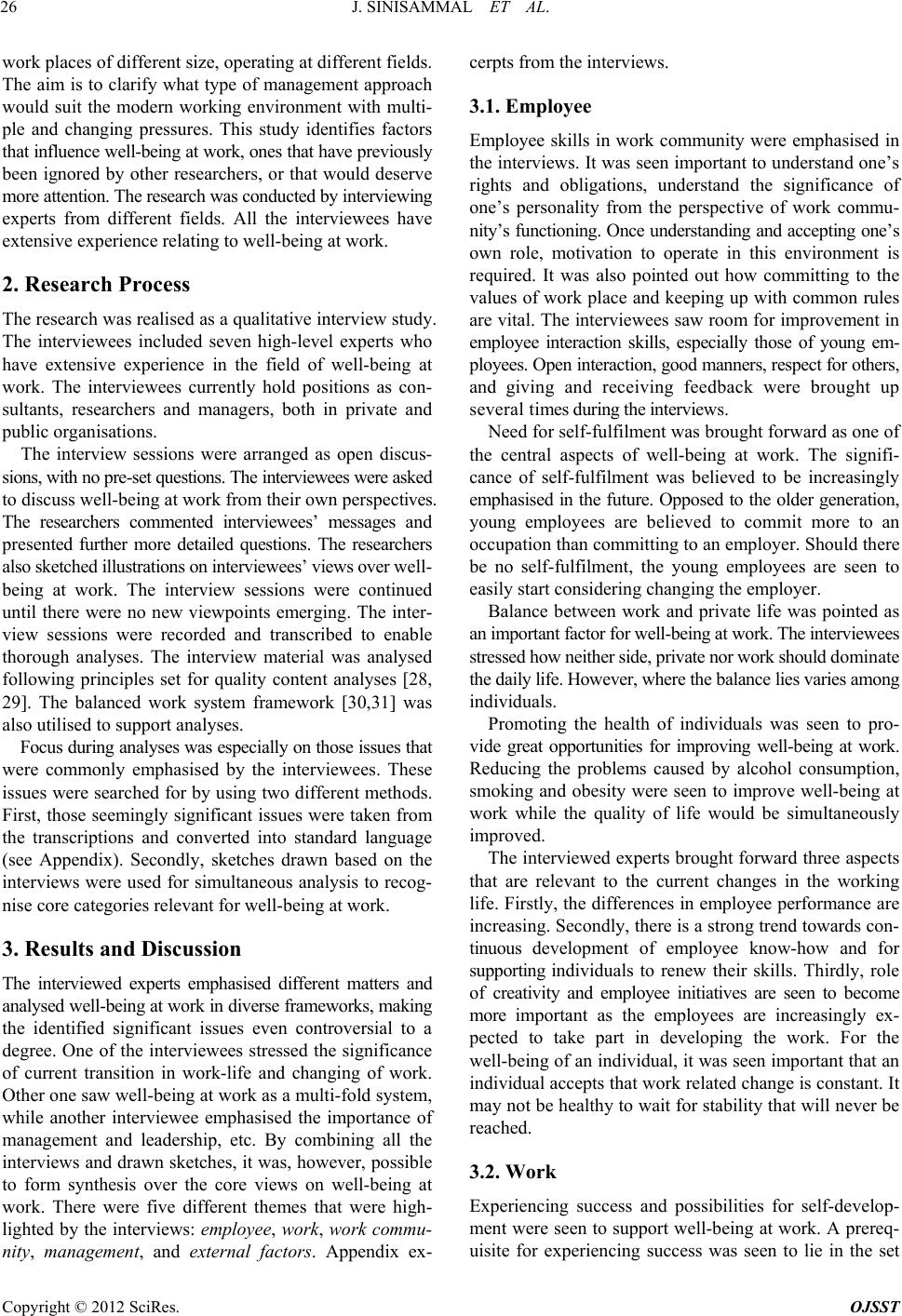 J. SINISAMMAL ET AL. 26 work places of different size, operating at different fields. The aim is to clarify what type of management approach would suit the modern working environment with multi- ple and changing pressures. This study identifies factors that influence well-being at work, ones that have previously been ignored by other researchers, or that would deserve more attention. The research was conducted by interviewing experts from different fields. All the interviewees have extensive experience relating to well-being at work. 2. Research Process The research was realised as a qualitative interview study. The interviewees included seven high-level experts who have extensive experience in the field of well-being at work. The interviewees currently hold positions as con- sultants, researchers and managers, both in private and public organisations. The interview sessions were arranged as open discus- sions, with no pre-set questions. The interviewees were asked to discuss well-being at work from their own perspectives. The researchers commented interviewees’ messages and presented further more detailed questions. The researchers also sketched illustrations on interviewees’ views over well- being at work. The interview sessions were continued until there were no new viewpoints emerging. The inter- view sessions were recorded and transcribed to enable thorough analyses. The interview material was analysed following principles set for quality content analyses [28, 29]. The balanced work system framework [30,31] was also utilised to support analyses. Focus during analyses was especially on those issues that were commonly emphasised by the interviewees. These issues were searched for by using two different methods. First, those seemingly significant issues were taken from the transcriptions and converted into standard language (see Appendix). Secondly, sketches drawn based on the interviews were used for simultaneous analysis to recog- nise core categories relevant for well-being at work. 3. Results and Discussion The interviewed experts emphasised different matters and analysed well-being at work in diverse frameworks, making the identified significant issues even controversial to a degree. One of the interviewees stressed the significance of current transition in work-life and changing of work. Other one saw well-being at work as a multi-fold system, while another interviewee emphasised the importance of management and leadership, etc. By combining all the interviews and drawn sketches, it was, however, possible to form synthesis over the core views on well-being at work. There were five different themes that were high- lighted by the interviews: employee, work, work commu- nity, management, and external factors. Appendix ex- cerpts from the interviews. 3.1. Employee Employee skills in work community were emphasised in the interviews. It was seen important to understand one’s rights and obligations, understand the significance of one’s personality from the perspective of work commu- nity’s functioning. Once understanding and accepting one’s own role, motivation to operate in this environment is required. It was also pointed out how committing to the values of work place and keeping up with common rules are vital. The interviewees saw room for improvement in employee interaction skills, especially those of young em- ployees. Open interaction, good manners, respect for others, and giving and receiving feedback were brought up several times during the interviews. Need for self-fulfilment was brought forward as one of the central aspects of well-being at work. The signifi- cance of self-fulfilment was believed to be increasingly emphasised in the future. Opposed to the older generation, young employees are believed to commit more to an occupation than committing to an employer. Should there be no self-fulfilment, the young employees are seen to easily start considering changing the employer. Balance between work and private life was pointed as an important factor for well-being at work. The interviewees stressed how neither side, private nor work should dominate the daily life. However, where the balance lies varies among individuals. Promoting the health of individuals was seen to pro- vide great opportunities for improving well-being at work. Reducing the problems caused by alcohol consumption, smoking and obesity were seen to improve well-being at work while the quality of life would be simultaneously improved. The interviewed experts brought forward three aspects that are relevant to the current changes in the working life. Firstly, the differences in employee performance are increasing. Secondly, there is a strong trend towards con- tinuous development of employee know-how and for supporting individuals to renew their skills. Thirdly, role of creativity and employee initiatives are seen to become more important as the employees are increasingly ex- pected to take part in developing the work. For the well-being of an individual, it was seen important that an individual accepts that work related change is constant. It may not be healthy to wait for stability that will never be reached. 3.2. Work Experiencing success and possibilities for self-develop- ment were seen to support well-being at work. A prereq- uisite for experiencing success was seen to lie in the set Copyright © 2012 SciRes. OJSST 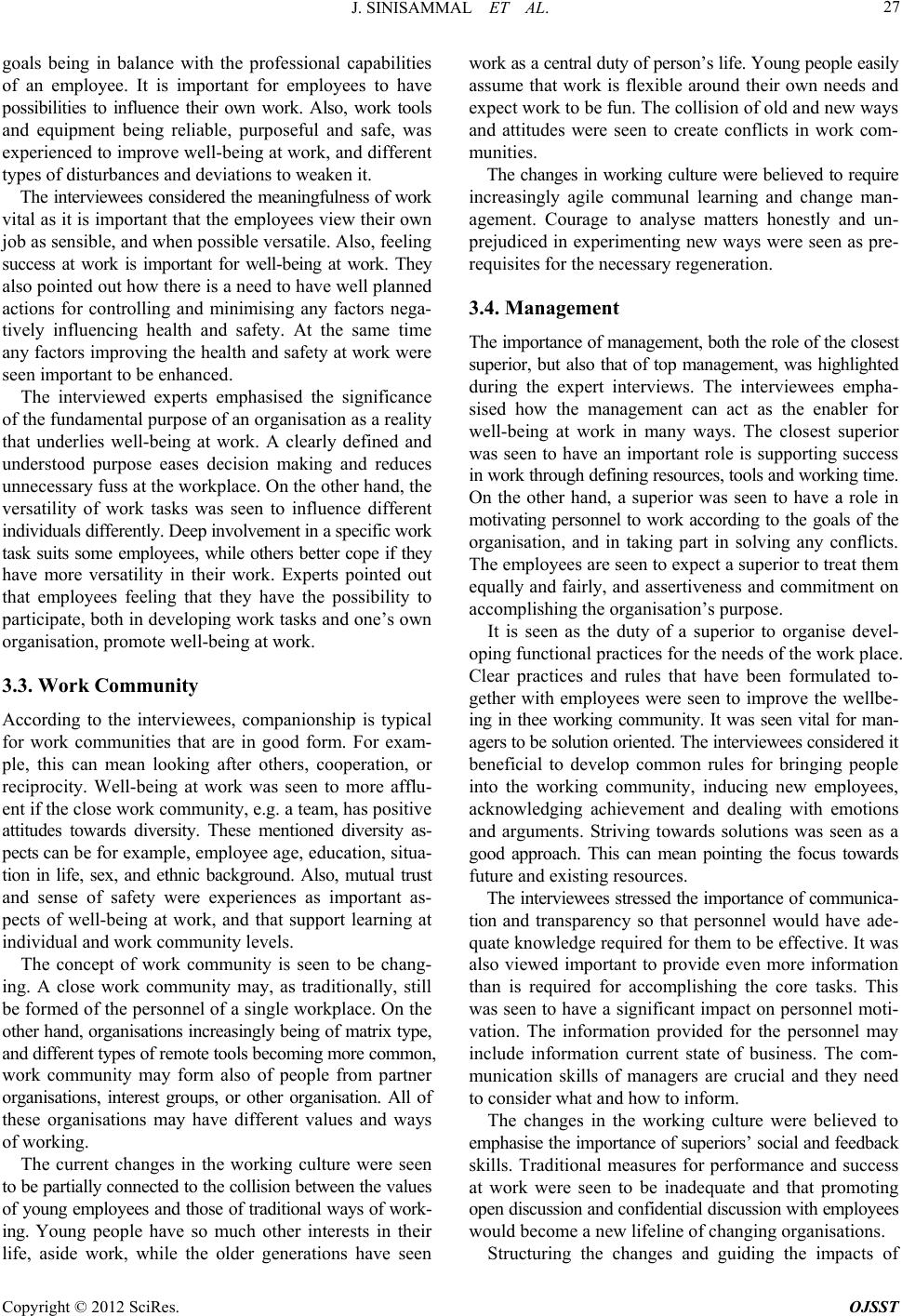 J. SINISAMMAL ET AL. 27 goals being in balance with the professional capabilities of an employee. It is important for employees to have possibilities to influence their own work. Also, work tools and equipment being reliable, purposeful and safe, was experienced to improve well-being at work, and different types of disturbances and deviations to weaken it. The interviewees considered the meaningfulness of work vital as it is important that the employees view their own job as sensible, and when possible versatile. Also, feeling success at work is important for well-being at work. They also pointed out how there is a need to have well planned actions for controlling and minimising any factors nega- tively influencing health and safety. At the same time any factors improving the health and safety at work were seen important to be enhanced. The interviewed experts emphasised the significance of the fundamental purpose of an organisation as a reality that underlies well-being at work. A clearly defined and understood purpose eases decision making and reduces unnecessary fuss at the workplace. On the other hand, the versatility of work tasks was seen to influence different individuals differently. Deep involvement in a specific work task suits some employees, while others better cope if they have more versatility in their work. Experts pointed out that employees feeling that they have the possibility to participate, both in developing work tasks and one’s own organisation, promote well-being at work. 3.3. Work Community According to the interviewees, companionship is typical for work communities that are in good form. For exam- ple, this can mean looking after others, cooperation, or reciprocity. Well-being at work was seen to more afflu- ent if the close work community, e.g. a team, has positive attitudes towards diversity. These mentioned diversity as- pects can be for example, employee age, education, situa- tion in life, sex, and ethnic background. Also, mutual trust and sense of safety were experiences as important as- pects of well-being at work, and that support learning at individual and work community levels. The concept of work community is seen to be chang- ing. A close work community may, as traditionally, still be formed of the personnel of a single workplace. On the other hand, organisations increasingly being of matrix type, and different types of remote tools becoming more common, work community may form also of people from partner organisations, interest groups, or other organisation. All of these organisations may have different values and ways of working. The current changes in the working culture were seen to be partially connected to the collision between the values of young employees and those of traditional ways of work- ing. Young people have so much other interests in their life, aside work, while the older generations have seen work as a central duty of person’s life. Young people easily assume that work is flexible around their own needs and expect work to be fun. The collision of old and new ways and attitudes were seen to create conflicts in work com- munities. The changes in working culture were believed to require increasingly agile communal learning and change man- agement. Courage to analyse matters honestly and un- prejudiced in experimenting new ways were seen as pre- requisites for the necessary regeneration. 3.4. Management The importance of management, both the role of the closest superior, but also that of top management, was highlighted during the expert interviews. The interviewees empha- sised how the management can act as the enabler for well-being at work in many ways. The closest superior was seen to have an important role is supporting success in work through defining resources, tools and working time. On the other hand, a superior was seen to have a role in motivating personnel to work according to the goals of the organisation, and in taking part in solving any conflicts. The employees are seen to expect a superior to treat them equally and fairly, and assertiveness and commitment on accomplishing the organisation’s purpose. It is seen as the duty of a superior to organise devel- oping functional practices for the needs of the work place. Clear practices and rules that have been formulated to- gether with employees were seen to improve the wellbe- ing in thee working community. It was seen vital for man- agers to be solution oriented. The interviewees considered it beneficial to develop common rules for bringing people into the working community, inducing new employees, acknowledging achievement and dealing with emotions and arguments. Striving towards solutions was seen as a good approach. This can mean pointing the focus towards future and existing resources. The interviewees stressed the importance of communica- tion and transparency so that personnel would have ade- quate knowledge required for them to be effective. It was also viewed important to provide even more information than is required for accomplishing the core tasks. This was seen to have a significant impact on personnel moti- vation. The information provided for the personnel may include information current state of business. The com- munication skills of managers are crucial and they need to consider what and how to inform. The changes in the working culture were believed to emphasise the importance of superiors’ social and feedback skills. Traditional measures for performance and success at work were seen to be inadequate and that promoting open discussion and confidential discussion with employees would become a new lifeline of changing organisations. Structuring the changes and guiding the impacts of Copyright © 2012 SciRes. OJSST  J. SINISAMMAL ET AL. 28 change towards the organisation’s goals were seen to be relevant for management. The interviewees highlighted the importance of change management, as no modern organisation is stable but changes constantly. The interview- ees brought, supporting both individual and communal learning, forward as one of the core management tasks. Measuring and observing well-being at work is challeng- ing as it relates to personal feelings and experiences. However, the turnover of employees was seen as a rough measure of well-being at work. The expert interviews em- phasised that there is a need for company originated prac- tices. Interviewed experts brought up the importance of man- agement culture. Management skills and management proc- esses were seen important to be timely and in-line with the field in question. Organisational values and rules must be acceptable for all individuals working in the organisa- tion. Individual values must adapt to organisation’s values and rules, not vice versa. 3.5. External Factors The possibilities of a single company, or a working com- munity, influencing legislation, labour or financial mar- kets, technology, competition, and other external factors are fairly limited. However, the influences of external factors were seen important to acknowledge and foresee to a degree. The expert interviewees highlighted the need to continuously assess external aspects that influence well- being at work. These continuous assessments and restruc- turings were seen as management’s core tasks. The inter- viewees also emphasises that work needs to be well planned, even if continuous change was present. The interviewees pointed how the emphasis on different factors influencing well-being at work differs according to company size, field, and surrounding culture. For ex- ample, construction sector and engineering work-shops emphasise safety issues, while welfare and health sector emphasise social interaction and group dynamics. The values and ways of working of working life are also seen to be different in different countries. The interviewees raised both macro and micro issues as external factors. The macro issues brought up included; local and global economics, laws and regulations, and busi- ness field and business communities. These macro aspects influence the company directly. The raised micro issues included; family and friends, personal human relations, and leisure time and hobbies. The micro issues influence the company employees, hence influencing their work. 4. Conclusions Well-being at work benefits employees, employers and the national economies. Current changes in the working life cause pressures on working communities and are seen important to be reacted upon. The aim of this research was to come up with such a description of aspects influencing well-being at work that would be applicable for different types of work places, in different fields. The research was conducted by interviewing experts in the field, currently working as researchers, consultants and managers, both in private and public organisations. According to the results of this research, well-being at work can be divided into five different themes; employee, work, work community, management, and external fac- tors. The results highlighted self-fulfilment as one of the central factors influencing well-being at work. Also, the significance of self-fulfilment was seen to be increasingly emphasised in the near future. Changing working culture, and related incompleteness of work, simultaneous changes and surprising changes of direction are seen to require working organisations to be more agile in communal learn- ing and in managing change. Changes in working culture are seen to emphasise the social and communication skills of managers. In addition, the traditional measures for per- formance are seen inadequate and that more open discus- sion is required with employees. It was emphasised how more reactive management is required for responding to internal and external changes. The results of this study can be illustrated as presented in Figure 1. The figure highlights the influence of insta- bility, caused by changes in the working life, on well- being at work. The significance of each element of well- being at work varies across business sectors, organisations size, culture, and other factors. Managers need to react to changes in the relations of employee, work community and work itself, as well as changes in the external factors. Factors that are included in work community include organising of work, workplace rules, values, trust, work- ing environment, and working relationships. Factors rele- vant for work, aside normal duties, include tools and working environment. Factors relevant for employee in- clude professional know-how, experienced health, work community skills, values and attitudes. The role of man- agement is seen as guiding continuous change processes influencing work, employees, and work community. This Employee Work Work community Management External factors Figure 1. Reactive management for well-being at work. Copyright © 2012 SciRes. OJSST 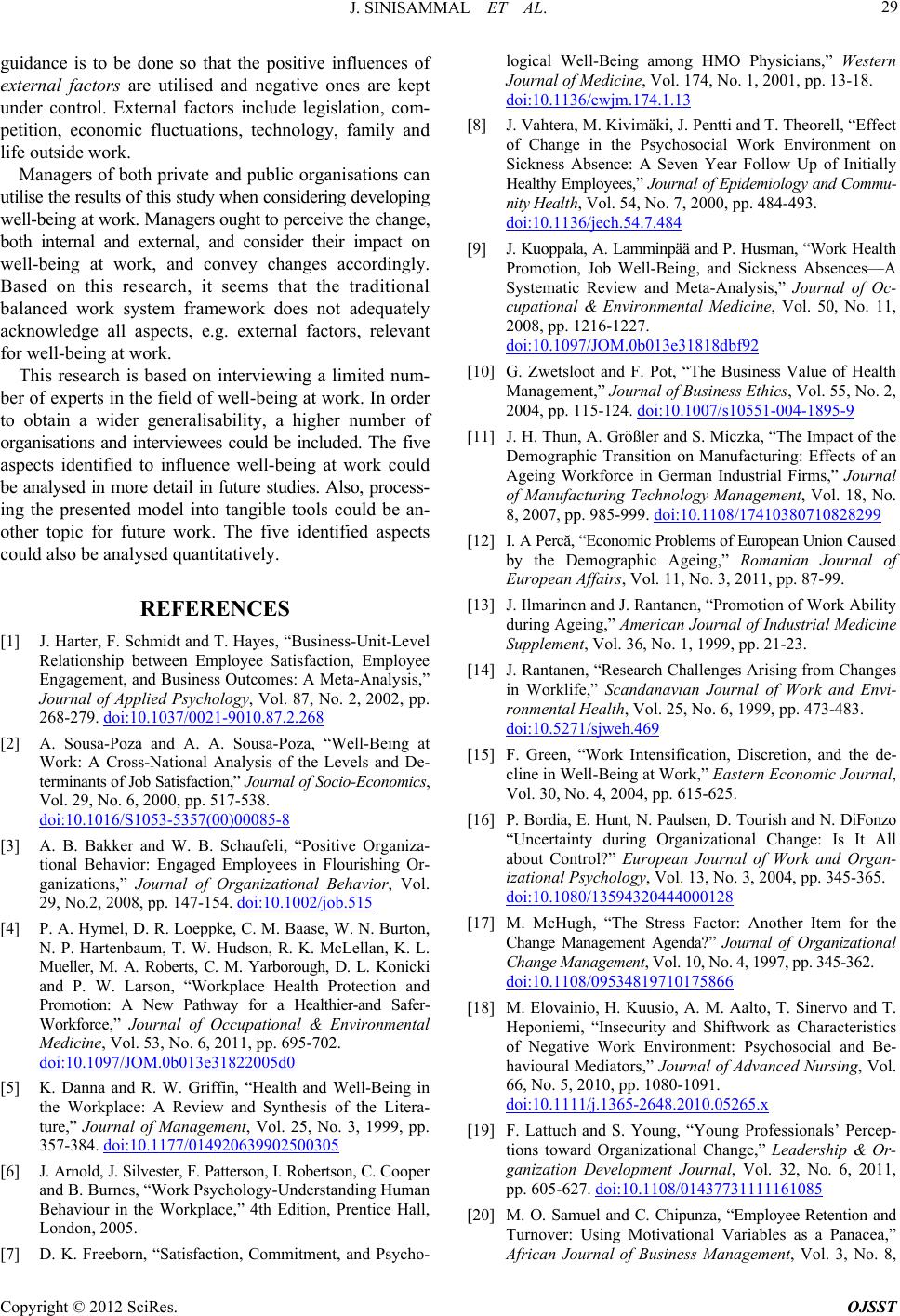 J. SINISAMMAL ET AL. 29 guidance is to be done so that the positive influences of external factors are utilised and negative ones are kept under control. External factors include legislation, com- petition, economic fluctuations, technology, family and life outside work. Managers of both private and public organisations can utilise the results of this study when considering developing well-being at work. Managers ought to perceive the change, both internal and external, and consider their impact on well-being at work, and convey changes accordingly. Based on this research, it seems that the traditional balanced work system framework does not adequately acknowledge all aspects, e.g. external factors, relevant for well-being at work. This research is based on interviewing a limited num- ber of experts in the field of well-being at work. In order to obtain a wider generalisability, a higher number of organisations and interviewees could be included. The five aspects identified to influence well-being at work could be analysed in more detail in future studies. Also, process- ing the presented model into tangible tools could be an- other topic for future work. The five identified aspects could also be analysed quantitatively. REFERENCES [1] J. Harter, F. Schmidt and T. Hayes, “Business-Unit-Level Relationship between Employee Satisfaction, Employee Engagement, and Business Outcomes: A Meta-Analysis,” Journal of Applied Psychology, Vol. 87, No. 2, 2002, pp. 268-279. doi:10.1037/0021-9010.87.2.268 [2] A. Sousa-Poza and A. A. Sousa-Poza, “Well-Being at Work: A Cross-National Analysis of the Levels and De- terminants of Job Satisfaction,” Journal of Socio-Economics, Vol. 29, No. 6, 2000, pp. 517-538. doi:10.1016/S1053-5357(00)00085-8 [3] A. B. Bakker and W. B. Schaufeli, “Positive Organiza- tional Behavior: Engaged Employees in Flourishing Or- ganizations,” Journal of Organizational Behavior, Vol. 29, No.2, 2008, pp. 147-154. doi:10.1002/job.515 [4] P. A. Hymel, D. R. Loeppke, C. M. Baase, W. N. Burton, N. P. Hartenbaum, T. W. Hudson, R. K. McLellan, K. L. Mueller, M. A. Roberts, C. M. Yarborough, D. L. Konicki and P. W. Larson, “Workplace Health Protection and Promotion: A New Pathway for a Healthier-and Safer- Workforce,” Journal of Occupational & Environmental Medicine, Vol. 53, No. 6, 2011, pp. 695-702. doi:10.1097/JOM.0b013e31822005d0 [5] K. Danna and R. W. Griffin, “Health and Well-Being in the Workplace: A Review and Synthesis of the Litera- ture,” Journal of Management, Vol. 25, No. 3, 1999, pp. 357-384. doi:10.1177/014920639902500305 [6] J. Arnold, J. Silvester, F. Patterson, I. Robertson, C. Cooper and B. Burnes, “Work Psychology-Understanding Human Behaviour in the Workplace,” 4th Edition, Prentice Hall, London, 2005. [7] D. K. Freeborn, “Satisfaction, Commitment, and Psycho- logical Well-Being among HMO Physicians,” Western Journal of Medicine, Vol. 174, No. 1, 2001, pp. 13-18. doi:10.1136/ewjm.174.1.13 [8] J. Vahtera, M. Kivimäki, J. Pentti and T. Theorell, “Effect of Change in the Psychosocial Work Environment on Sickness Absence: A Seven Year Follow Up of Initially Healthy Employees,” Journal of Epidemiology and Commu- nit y He alth, Vol. 54, No. 7, 2000, pp. 484-493. doi:10.1136/jech.54.7.484 [9] J. Kuoppala, A. Lamminpää and P. Husman, “Work Health Promotion, Job Well-Being, and Sickness Absences—A Systematic Review and Meta-Analysis,” Journal of Oc- cupational & Environmental Medicine, Vol. 50, No. 11, 2008, pp. 1216-1227. doi:10.1097/JOM.0b013e31818dbf92 [10] G. Zwetsloot and F. Pot, “The Business Value of Health Management,” Journal of Business Ethics, Vol. 55, No. 2, 2004, pp. 115-124. doi:10.1007/s10551-004-1895-9 [11] J. H. Thun, A. Größler and S. Miczka, “The Impact of the Demographic Transition on Manufacturing: Effects of an Ageing Workforce in German Industrial Firms,” Journal of Manufacturing Technology Management, Vol. 18, No. 8, 2007, pp. 985-999. doi:10.1108/17410380710828299 [12] I. A Percă, “Economic Problems of European Union Caused by the Demographic Ageing,” Romanian Journal of European Affairs, Vol. 11, No. 3, 2011, pp. 87-99. [13] J. Ilmarinen and J. Rantanen, “Promotion of Work Ability during Ageing,” American Journal of Industrial Medicine Supplement, Vol. 36, No. 1, 1999, pp. 21-23. [14] J. Rantanen, “Research Challenges Arising from Changes in Worklife,” Scandanavian Journal of Work and Envi- ronmental Health, Vol. 25, No. 6, 1999, pp. 473-483. doi:10.5271/sjweh.469 [15] F. Green, “Work Intensification, Discretion, and the de- cline in Well-Being at Work,” Eastern Economic Journal, Vol. 30, No. 4, 2004, pp. 615-625. [16] P. Bordia, E. Hunt, N. Paulsen, D. Tourish and N. DiFonzo “Uncertainty during Organizational Change: Is It All about Control?” European Journal of Work and Organ- izational Psychology, Vol. 13, No. 3, 2004, pp. 345-365. doi:10.1080/13594320444000128 [17] M. McHugh, “The Stress Factor: Another Item for the Change Management Agenda?” Journal of Organizational Change Management, Vol. 10, No. 4, 1997, pp. 345-362. doi:10.1108/09534819710175866 [18] M. Elovainio, H. Kuusio, A. M. Aalto, T. Sinervo and T. Heponiemi, “Insecurity and Shiftwork as Characteristics of Negative Work Environment: Psychosocial and Be- havioural Mediators,” Journal of Advanced Nursing, Vol. 66, No. 5, 2010, pp. 1080-1091. doi:10.1111/j.1365-2648.2010.05265.x [19] F. Lattuch and S. Young, “Young Professionals’ Percep- tions toward Organizational Change,” Leadership & Or- ganization Development Journal, Vol. 32, No. 6, 2011, pp. 605-627. doi:10.1108/01437731111161085 [20] M. O. Samuel and C. Chipunza, “Employee Retention and Turnover: Using Motivational Variables as a Panacea,” African Journal of Business Management, Vol. 3, No. 8, Copyright © 2012 SciRes. OJSST 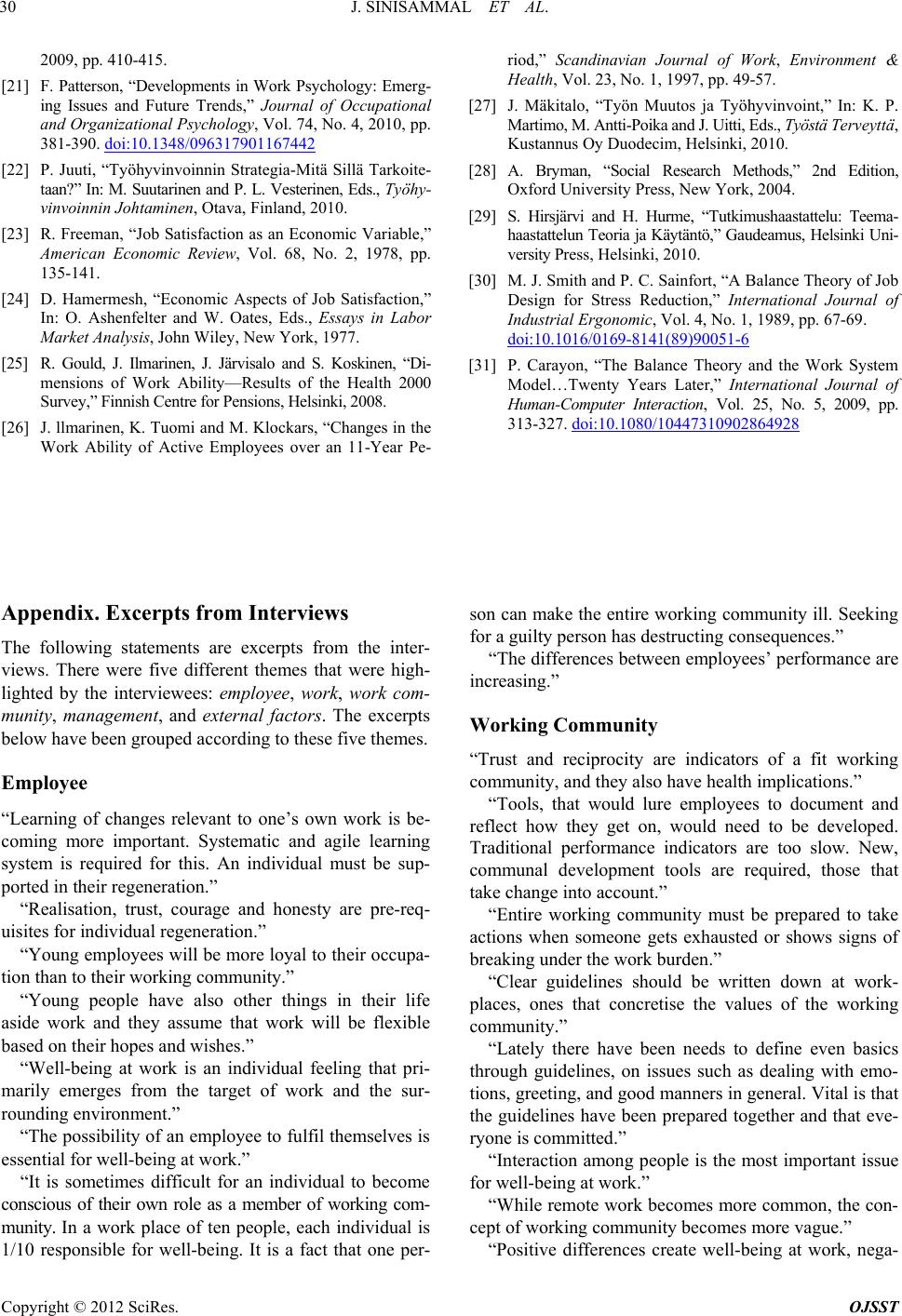 J. SINISAMMAL ET AL. Copyright © 2012 SciRes. OJSST 30 2009, pp. 410-415. [21] F. Patterson, “Developments in Work Psychology: Emerg- ing Issues and Future Trends,” Journal of Occupational and Organizational Psychology, Vol. 74, No. 4, 2010, pp. 381-390. doi:10.1348/096317901167442 [22] P. Juuti, “Työhyvinvoinnin Strategia-Mitä Sillä Tarkoite- taan?” In: M. Suutarinen and P. L. Vesterinen, Eds., Työhy- vinvoinnin Johtaminen, Otava, Finland, 2010. [23] R. Freeman, “Job Satisfaction as an Economic Variable,” American Economic Review, Vol. 68, No. 2, 1978, pp. 135-141. [24] D. Hamermesh, “Economic Aspects of Job Satisfaction,” In: O. Ashenfelter and W. Oates, Eds., Essays in Labor Market Analysis, John Wiley, New York, 1977. [25] R. Gould, J. Ilmarinen, J. Järvisalo and S. Koskinen, “Di- mensions of Work Ability—Results of the Health 2000 Survey,” Finnish Centre for Pensions, Helsinki, 2008. [26] J. llmarinen, K. Tuomi and M. Klockars, “Changes in the Work Ability of Active Employees over an 11-Year Pe- riod,” Scandinavian Journal of Work, Environment & Health, Vol. 23, No. 1, 1997, pp. 49-57. [27] J. Mäkitalo, “Työn Muutos ja Työhyvinvoint,” In: K. P. Martimo, M. Antti-Poika and J. Uitti, Eds., Työst ä T ervey ttä, Kustannus Oy Duodecim, Helsinki, 2010. [28] A. Bryman, “Social Research Methods,” 2nd Edition, Oxford University Press, New York, 2004. [29] S. Hirsjärvi and H. Hurme, “Tutkimushaastattelu: Teema- haastattelun Teoria ja Käytäntö,” Gaudeamus, Helsinki Uni- versity Press, Helsinki, 2010. [30] M. J. Smith and P. C. Sainfort, “A Balance Theory of Job Design for Stress Reduction,” International Journal of Industrial Ergonomic, Vol. 4, No. 1, 1989, pp. 67-69. doi:10.1016/0169-8141(89)90051-6 [31] P. Carayon, “The Balance Theory and the Work System Model…Twenty Years Later,” International Journal of Human-Computer Interaction, Vol. 25, No. 5, 2009, pp. 313-327. doi:10.1080/10447310902864928 Appendix. Excerpts from Interviews The following statements are excerpts from the inter- views. There were five different themes that were high- lighted by the interviewees: employee, work, work com- munity, management, and external factors. The excerpts below have been grouped according to these five themes. Employee “Learning of changes relevant to one’s own work is be- coming more important. Systematic and agile learning system is required for this. An individual must be sup- ported in their regeneration.” “Realisation, trust, courage and honesty are pre-req- uisites for individual regeneration.” “Young employees will be more loyal to their occupa- tion than to their working community.” “Young people have also other things in their life aside work and they assume that work will be flexible based on their hopes and wishes.” “Well-being at work is an individual feeling that pri- marily emerges from the target of work and the sur- rounding environment.” “The possibility of an employee to fulfil themselves is essential for well-being at work.” “It is sometimes difficult for an individual to become conscious of their own role as a member of working com- munity. In a work place of ten people, each individual is 1/10 responsible for well-being. It is a fact that one per- son can make the entire working community ill. Seeking for a guilty person has destructing consequences.” “The differences between employees’ performance are increasing.” Working Community “Trust and reciprocity are indicators of a fit working community, and they also have health implications.” “Tools, that would lure employees to document and reflect how they get on, would need to be developed. Traditional performance indicators are too slow. New, communal development tools are required, those that take change into account.” “Entire working community must be prepared to take actions when someone gets exhausted or shows signs of breaking under the work burden.” “Clear guidelines should be written down at work- places, ones that concretise the values of the working community.” “Lately there have been needs to define even basics through guidelines, on issues such as dealing with emo- tions, greeting, and good manners in general. Vital is that the guidelines have been prepared together and that eve- ryone is committed.” “Interaction among people is the most important issue for well-being at work.” “While remote work becomes more common, the con- cept of working community becomes more vague.” “Positive differences create well-being at work, nega- 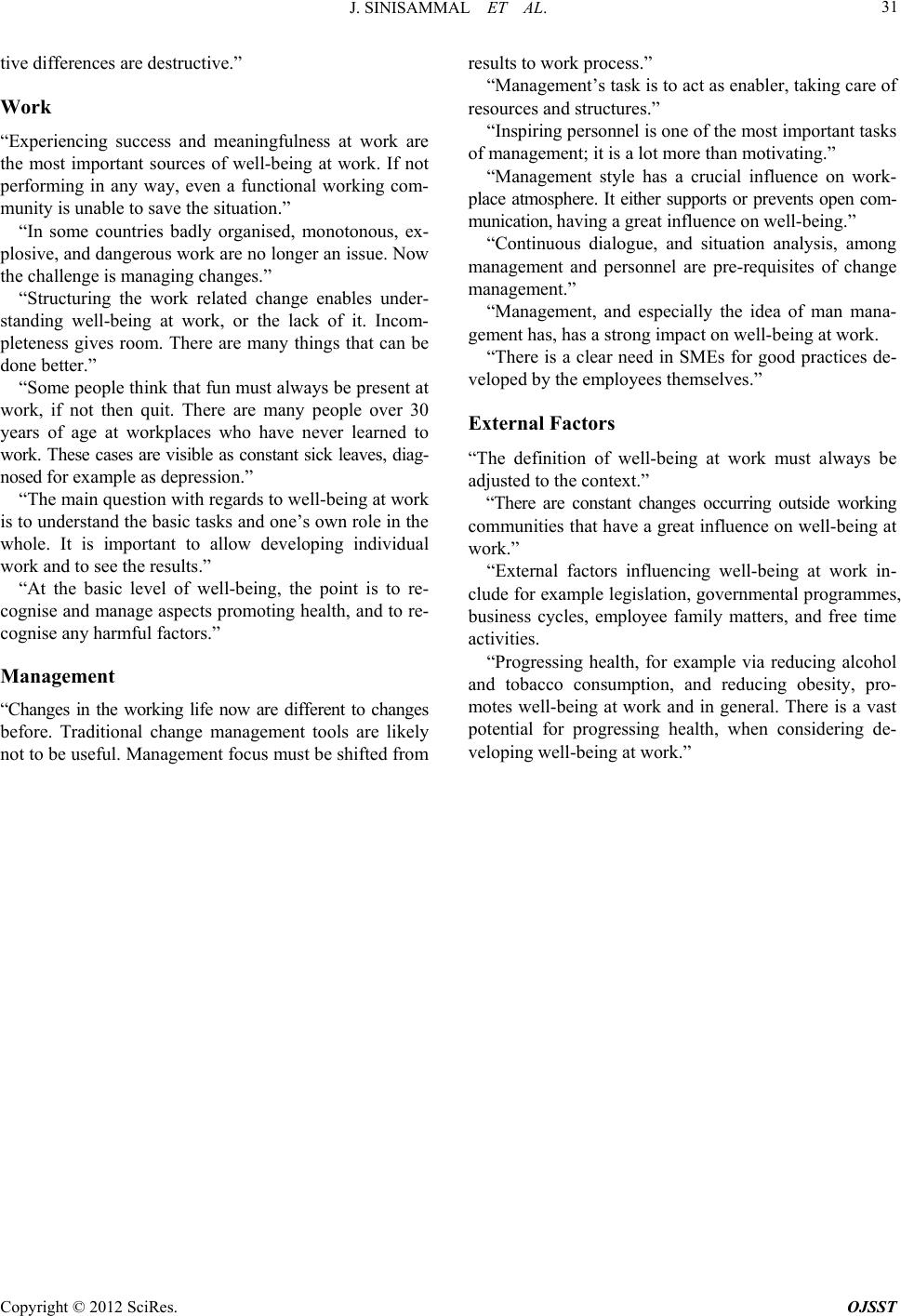 J. SINISAMMAL ET AL. 31 tive differences are destructive.” Work “Experiencing success and meaningfulness at work are the most important sources of well-being at work. If not performing in any way, even a functional working com- munity is unable to save the situation.” “In some countries badly organised, monotonous, ex- plosive, and dangerous work are no longer an issue. Now the challenge is managing changes.” “Structuring the work related change enables under- standing well-being at work, or the lack of it. Incom- pleteness gives room. There are many things that can be done better.” “Some people think that fun must always be present at work, if not then quit. There are many people over 30 years of age at workplaces who have never learned to work. These cases are visible as constant sick leaves, diag- nosed for example as depression.” “The main question with regards to well-being at work is to understand the basic tasks and one’s own role in the whole. It is important to allow developing individual work and to see the results.” “At the basic level of well-being, the point is to re- cognise and manage aspects promoting health, and to re- cognise any harmful factors.” Management “Changes in the working life now are different to changes before. Traditional change management tools are likely not to be useful. Management focus must be shifted from results to work process.” “Management’s task is to act as enabler, taking care of resources and structures.” “Inspiring personnel is one of the most important tasks of management; it is a lot more than motivating.” “Management style has a crucial influence on work- place atmosphere. It either supports or prevents open com- munication, having a great influence on well-being.” “Continuous dialogue, and situation analysis, among management and personnel are pre-requisites of change management.” “Management, and especially the idea of man mana- gement has, has a strong impact on well-being at work. “There is a clear need in SMEs for good practices de- veloped by the employees themselves.” External Factors “The definition of well-being at work must always be adjusted to the context.” “There are constant changes occurring outside working communities that have a great influence on well-being at work.” “External factors influencing well-being at work in- clude for example legislation, governmental programmes, business cycles, employee family matters, and free time activities. “Progressing health, for example via reducing alcohol and tobacco consumption, and reducing obesity, pro- motes well-being at work and in general. There is a vast potential for progressing health, when considering de- veloping well-being at work.” Copyright © 2012 SciRes. OJSST
|